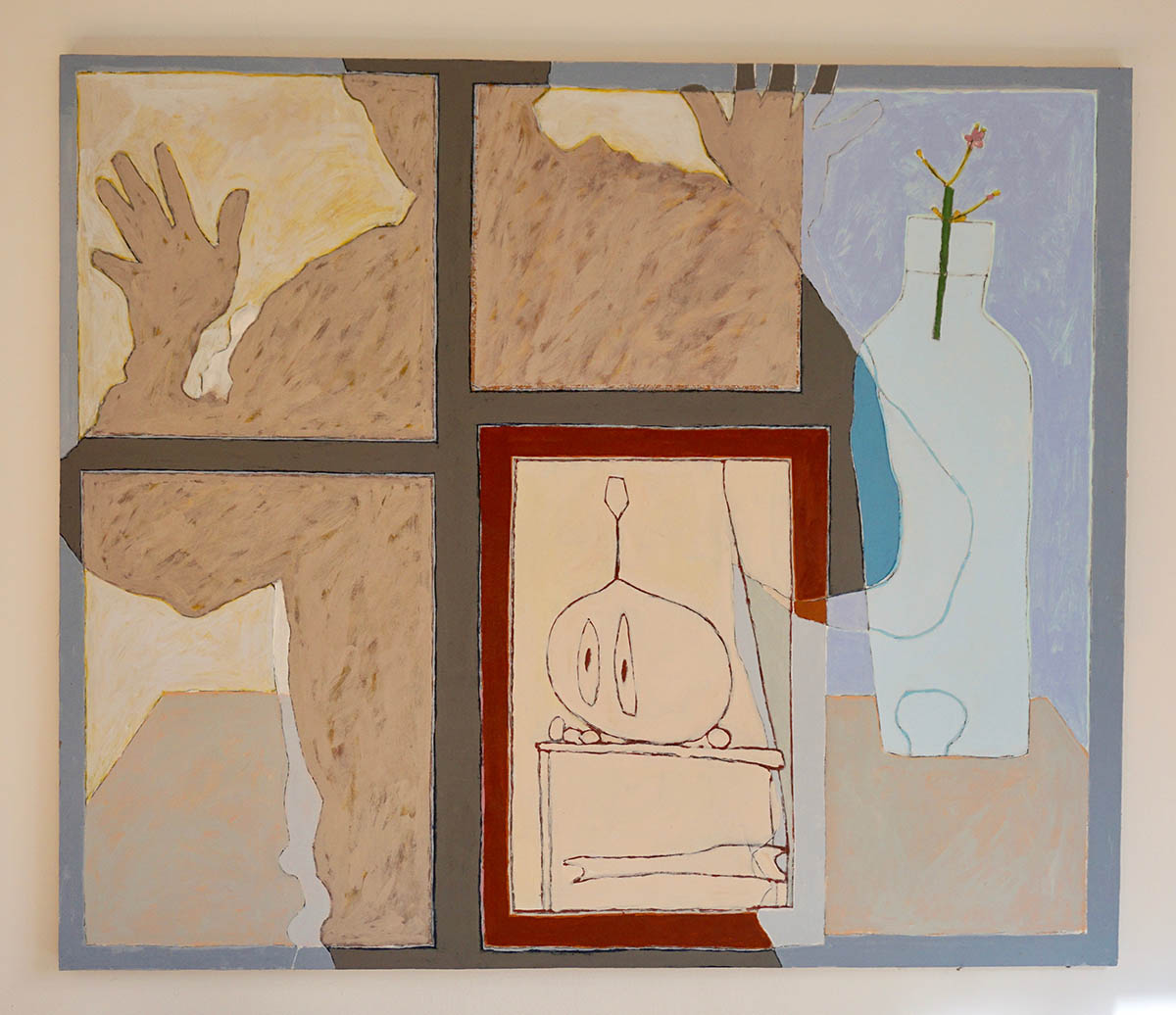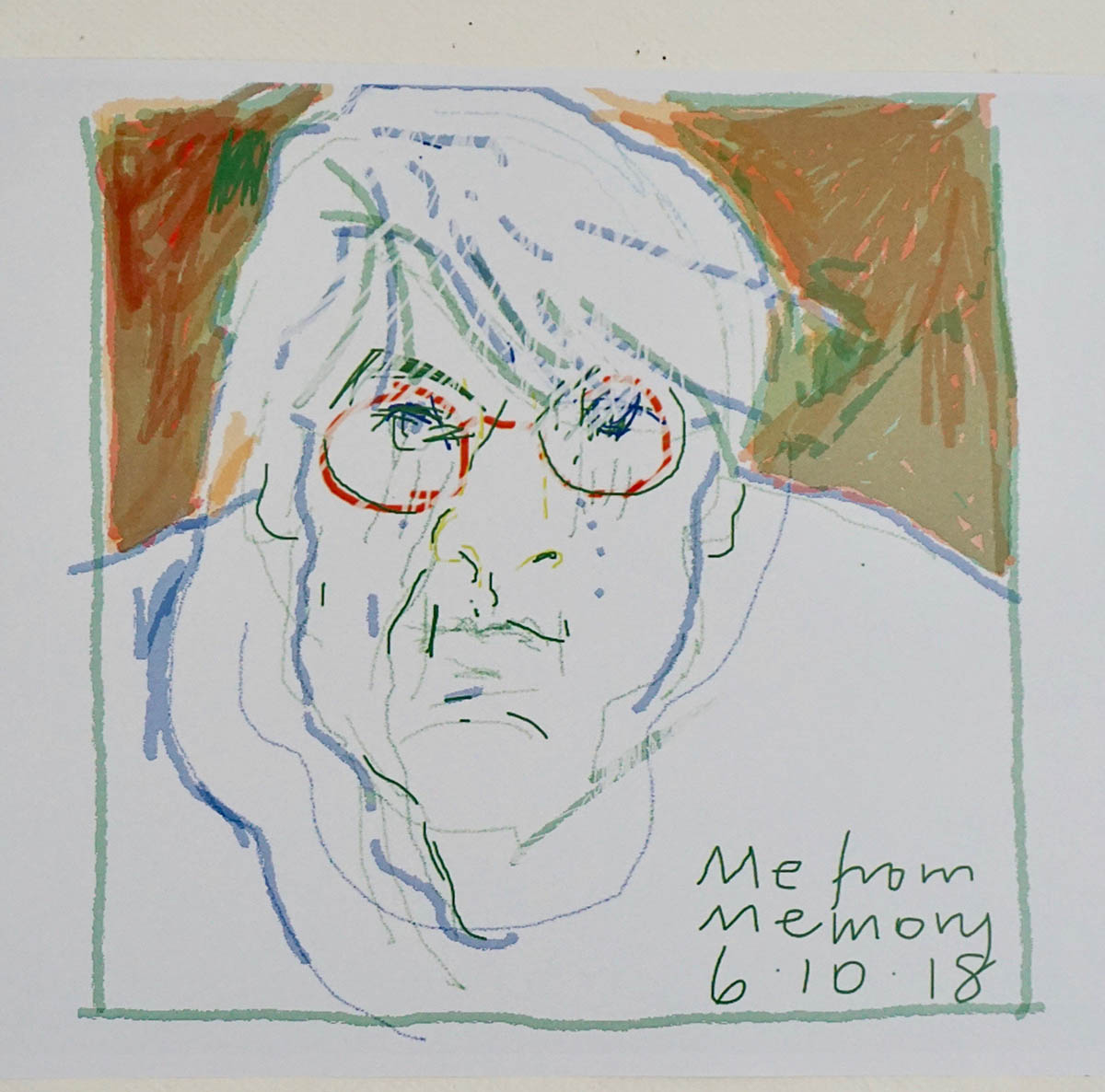Ivor Weeks 8.12.1929 – 12.2.2019
We would like to thank Chris Crickmay and John Hall for contributing this obituary

This painting by Ivor hung prominently in his own home
Ivor Weeks, who died in Torbay Hospital on February 12th, was admired and much liked by hundreds of students, colleagues and friends, especially at Dartington, where he lived for over sixty years and worked, first in the Adult Education Centre in the Lescaze building at Shinners Bridge, then at the College of Arts, and throughout as a painter. He was a dedicated teacher with strong social principles, who played a significant part in developing, leading and steadying the development of visual art courses at Dartington. Qualities of his that have been remarked on by those who worked with him include integrity, grace and sensitivity. As a teacher, his preference was to listen and inspire rather than instruct.
Ivor was born in Bradford-on-Avon in 1929 to Walter and Dorothy (née Paine) and lived in the town until Grammar School was over and it was time for National Service. It is typical of him that he turned down an offer of officer training and was always proud to have been referred to as ‘bloody Weeks’. From there he went on to what had been long planned, his much loved time at Corsham (Bath Academy of Art), where he was by all accounts a very successful student. Much of what he appreciated at Corsham, he brought with him to Dartington, including a teaching ethos that was open, informal and relaxed and an emphasis on training art teachers as artists in their own right.
A key event for Ivor at Corsham was meeting his future wife, Maureen Williams. Soon after finishing the course in 1951, Ivor and Mo got married, thus affirming their close and lasting partnership, which was “a marriage and more”, according to the family.
Arriving at 26, fresh from teaching at Portway secondary school in Bristol, Ivor had described Dartington to Maureen as “some sort of paradise”. Almost immediately, under Ivor’s direction, the Adult Education Centre took off, with courses for adults, for children and for teachers. Ivor gathered around him an enthusiastic following of adult students taking day and evening courses, including George Passmore of Gilbert and George, who has spoken with gratitude about Ivor’s advice to him. By 1962 numbers attending courses in painting, pottery, textiles and drawing had grown to 230. Cars lined the road outside the Centre for the widely acclaimed annual open evening. Gradually, other courses emerged, often on a tiny scale to start with. In 1959 a Summer School of Art was launched, which ran on successfully into the early 1980s.
Following the earlier establishment of Diplomas in Music and Theatre, and a Pre-Diploma course in art, launched in 1964/5, a 2 year Art Teachers Diploma was set up in 1967, starting with just 15 students. By then Ivor had brought in a number of other staff also trained at Corsham, and the general approach was strongly Corsham influenced.
By the mid 1980s, the Department of Art and Design was running a 3 year degree course entitled ‘Art and Social Context’ – one of the first of its kind in higher education. By then the long-standing focus on training teachers in the Corsham manner had been supplanted by other influences. It was much to Ivor’s credit that he gave himself to supporting these later changes, bringing to them his own unique range of skills and experience.
It is striking how warmly and with how much respect, Ivor is thought of by ex-colleagues and ex-students alike. For example, Sally Tallant, an ex-student of Ivor’s, who has recently been appointed Director of the Queens Museum in New York, responded to news of Ivor’s death with these words:
“When I went to Dartington in 1986 I was lost and confused. Ivor Weeks was a great teacher and guide and he helped me to find focus, direction and confidence. I remember his patience and kindness with great affection and know that all of us who were taught by him are a legacy to his gentle pedagogy.”
As a painter Ivor did not seek out a reputation, though, given the quality and originality of his work, the choice was his to make. Like the man, his work was calm, reflective, and orderly, but at the same time colourful and inventive. Ivor always insisted that his work had no particular meaning beyond an interest in looking. Be that as it may, what splendid and original looking it was! Like many painters, especially in the Modernist period, he drew upon his immediate surroundings for inspiration, working from observation, often also from photographs. The imagery in his paintings and drawings was almost entirely domestic, based in his own home. His subject matter included family members, domestic artifacts and ornaments, doors, windows, mirrors, toys, and children’s drawings. Through his painting he took this given world apart and re-configured it. His early interest in collage was reflected in his preference for a discontinuous pictorial space, often with overlapping planes of imagery or colour.
If all this sounds insular, it was not, since Ivor’s vision was broad and his interest in the art of many periods was intense. He drew inspiration both from modern masters such as Matisse and Braque, his contemporaries, such as William Scott, Robert Rauschenberg, R.B. Kitaj, and from artists of the past, such as Velasquez and Rembrandt. He has left behind a substantial collection of work. Maureen’s influence on Ivor’s work was considerable, since they worked in parallel as painters, often taught together in the early years and together created a family home at Bewhay in Dartington village that doubled as a studio and, to visitors, looked like an art gallery.
Ivor and Mo had four children. The first, Jo, was born in 1954 and sadly died in 2001, Mo died in 2010. Becki, Dom and Ben survive them.
His last years were spent in 2 Tower Cottages, overlooking both the church tower and the back of what were once Art Department buildings.
Chris Crickmay and John Hall
March 2019

‘Me from Memory’. The ‘Me’ is Ivor, drawn on his iPad

I was taught by Ivor and Mo from 1977 who both made a lasting impression and influence on me and just missed seeing Ivor last November when I came back to Dartington for a visit with a fellow student from that time Francisca Molhuysen .I only found out about his death by chance a few weeks ago .During the last 30 years I have worked as a painter , lecturer and course leader myself in particular in Bath and at Bath Spa University ( originally Bath Academy at Corsham ) and often feel that I am still linked to their Dartington and Corsham influences and approaches .Nice to hear the comments above from Graham ,Jenny and John .You May remember me as Fhiona Allsopp
Now Fhiona Mckie (nee Aitken )
Talking to Ivor was discovering the untold history of Dartington college of arts and the artists he rubbed shoulders with. It was a testament to his contribution to Art that Gilbert and George attended Ivor’s celebration party last Sunday. Ivor had introduced George Passmore to Art and after teaching him drawing at the Adult Education centre, Ivor encouraged George to enrol at the College of Arts. Of course the rest is history and Gilbert and George are now internationally acclaimed artists and members of the Royal Academy of Arts. George Passmore said that without Ivor’s influence he would have probably become a teacher or worked in a bank.
Strange to say but I read with gentle pleasure my father’s obituary. Thank you John and Chris.
One thing to add to the “close and lasting partnership” of Ivor and Mo : Ivor himself always attested what a strong influence Mo was on him. They both aided the other to be what they were.
In other words you couldn’t have one without the other (but maybe I would say that being their son).
I was lucky enough to have been both a student of Ivor’s in the early 1960s when there were only 10 art students, then a colleague of his during the period of the art teachers’ diploma. Ivor was always warm and approachable and created a department where everyone, no matter what their role, could feel they and their work were equally valued. This brought out the best in everyone and we all benefited from his enthusiastic approach to teaching art and his benign influence in the department.
I was too late at Dartington to have known Ivor Weeks, but very much wish I had. He sounds like a quietly inspirational man with great integrity, imagination and commitment to the things and relationships that really matter. Thank you Chris and John for writing such a beautiful and tender obituary .
Lovely man, who had many endearing qualities, not least that he loved cricket!
Ivor features in my fondest memories of Dartington
Yes, Graham. He played at least once for the Wiltshire Under 16s. His cream cap is still to be seen.